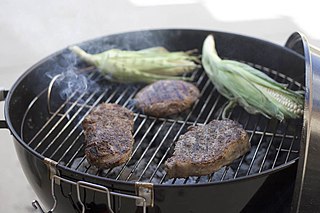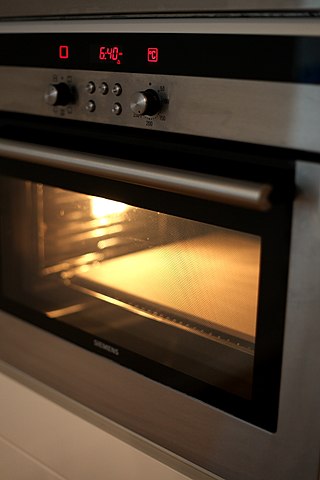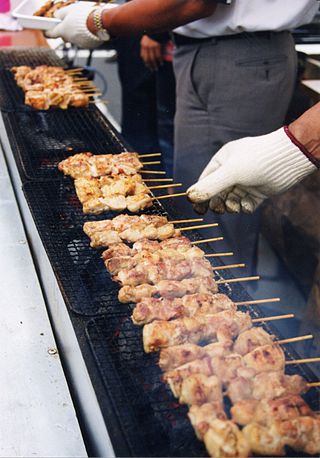
Cajun cuisine is a style of cooking developed by the Cajun–Acadians who were deported from Acadia to Louisiana during the 18th century and who incorporated West African, French and Spanish cooking techniques into their original cuisine.

Barbecue or barbeque is a term used with significant regional and national variations to describe various cooking methods that employ live fire and smoke to cook the food. The term is also generally applied to the devices associated with those methods, the broader cuisines that these methods produce, and the meals or gatherings at which this style of food is cooked and served. The cooking methods associated with barbecuing vary significantly but most involve outdoor cooking.

Grilling is a form of cooking that involves heat applied to the surface of food, commonly from above, below or from the side. Grilling usually involves a significant amount of direct, radiant heat, and tends to be used for cooking meat and vegetables quickly. Food to be grilled is cooked on a grill, using a cast iron/frying pan, or a grill pan.

Outdoor cooking is the preparation of food in the outdoors. A significant body of techniques and specialized equipment exists for it, traditionally associated with nomad in cultures such as the Berbers of North Africa, the Arab Bedouins, the Plains Indians, pioneers in North America, and indigenous tribes in South America. These methods have been refined in modern times for use during recreational outdoor pursuits, by campers and backpackers.

A barbecue grill or barbeque grill is a device that cooks food by applying heat from below. There are several varieties of grills, with most falling into one of three categories: gas-fueled, charcoal, or electric. There is debate over which method yields superior results.

An oven is a tool which is used to expose materials to a hot environment. Ovens contain a hollow chamber and provide a means of heating the chamber in a controlled way. In use since antiquity, they have been used to accomplish a wide variety of tasks requiring controlled heating. Because they are used for a variety of purposes, there are many different types of ovens. These types differ depending on their intended purpose and based upon how they generate heat.

Scrambled eggs is a dish made from eggs stirred, whipped, or beaten together typically with salt, butter, oil, and sometimes other ingredients, and heated so that they form into curds.

Makiyakinabe are square or rectangular cooking pans used to make Japanese-style rolled omelettes. The pans are commonly made from metals such as copper and tin, and can also be coated with a non-stick surface. Dimensions and proportions of the pan vary among regions of Japan, but it is always rectangular. Rolled omelettes made with makiyakinabe are commonly used as a side dish in sushi and bentō.

A kitchen stove, often called simply a stove or a cooker, is a kitchen appliance designed for the purpose of cooking food. Kitchen stoves rely on the application of direct heat for the cooking process and may also contain an oven, used for baking. "Cookstoves" are heated by burning wood or charcoal; "gas stoves" are heated by gas; and "electric stoves" by electricity. A stove with a built-in cooktop is also called a range.

A convection oven is an oven that has fans to circulate air around food to create an evenly heated environment. The increased air circulation causes a fan-assisted oven to cook food faster than a conventional non-fan oven, which relies only on natural convection to circulate the hot air. Fan-assisted convection ovens are commonly used for baking as well as non-food, industrial applications. Small countertop convection ovens for household use are often marketed as air fryers.

Ina Rosenberg Garten is an American television cook and author. She is host of the Food Network program Barefoot Contessa, and was a former staff member of the Office of Management and Budget. Among her dishes are Perfect Roast Chicken, Weeknight Bolognese, French Apple Tart, and a simplified version of beef bourguignon. Her culinary career began with her gourmet food store, Barefoot Contessa; Garten then expanded her activities to many best-selling cookbooks, magazine columns, and a popular Food Network television show.

Garlic bread consists of bread, topped with garlic and occasionally olive oil or butter and may include additional herbs, such as oregano or chives. It is then either grilled until toasted or baked in a conventional or bread oven.

A baking stone is a portable cooking surface used in baking. It may be made of ceramic, stone or, more recently, salt. Food is put on the stone, which is then placed in an oven, though sometimes the stone is heated first. Baking stones are used much like cookie sheets, but may absorb additional moisture for crispier food. A pizza stone is a baking stone designed for cooking pizza.

Bean dip is a type of dipping sauce made using beans or refried beans as a primary ingredient. It is typically served with tortilla chips, and can also be served with other foods such as crackers and crudités. Various types of beans are used, and fresh-cooked, canned or flaked beans can be used. Various additional ingredients are used in its preparation, such as onion, garlic, chili peppers and spices, and it is sometimes garnished with some ingredients. Bean dip can be served cold, at room temperature, or hot. Bean dip is sometimes used as an ingredient in the preparation of other dishes such as burritos and quesadillas.

Yakitori is a Japanese type of skewered chicken. Its preparation involves attaching the meat to a skewer, typically made of steel or bamboo, after which it is grilled over a charcoal fire. During or after cooking, the meat is typically seasoned with tare sauce or salt. The term is sometimes used informally for kushiyaki in general.

In Japanese cuisine, robatayaki, often shortened to robata, refers to a method of cooking, similar to barbecue, in which items of food are cooked at varying speeds over hot charcoal. Many Japanese restaurants, both in Japan and abroad, specialize in this style of food preparation. Traditionally, the food consists of a combination of morsels of seafood and vegetables, but other kinds of food that are suitable for grilling may also be offered. The robata cooking style is different from other Japanese charcoal cooking in that it uses a wide, flat open fireplace in the style of an irori, rather than a shichirin or other type of charcoal cooking implement.

Acquacotta is a hot broth-based bread soup in Italian cuisine that was originally a peasant food. Its preparation and consumption dates back to ancient history, and it originated in the coastal area known as the Maremma, in southern Tuscany and northern Lazio. The dish was invented in part as a means to make hardened, stale bread edible. In contemporary times, ingredients can vary, and additional ingredients are sometimes used. Variations of the dish include acquacotta con funghi and acquacotta con peperoni.

















